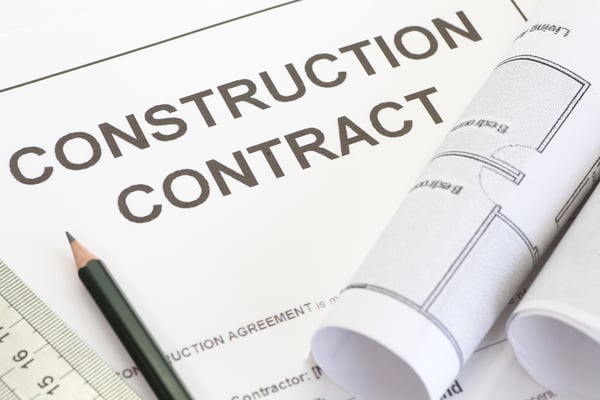A construction project involves many different parties, including owners, designers, engineers, architects, contractors, subcontractors and suppliers. As each party has its own interests, it is important to create a document that serves as protection and guarantee for everyone involved. Construction projects also present many risks and the document must indicate how they are distributed.
A construction contract is a document that creates a legally binding agreement between all parties. The purpose of a construction contract is:
- Distribute responsibilities and duties between the parties.
- Risk management: Determine project risks and allocate them among different parties.
- Reduce uncertainty and resolve any doubts regarding the project.
A construction contract also establishes project compensation and how it will be distributed. There are several types of contracts used in industry, but a few specific types are most commonly used in construction: Cost Plus Contract, Lump Sum or Fixed Price Contract, Unit Price Contract, and Time and Materials Contract .
Reduce project costs and mitigate risks with effective construction management.
Construction contracts are typically classified according to payment terms. Contracts also establish specifications, quality requirements, project schedules, and deadlines. Any type of contract can be customized to meet specific project needs. This article provides an overview of the main contract types used in construction.
Cost-plus contracts
In this type of contract, the contractor is paid based on actual purchases, labor costs and other expenses generated on the job. The contract includes all direct and indirect costs, plus a specific fee. Cost-plus contracts must detail a pre-negotiated amount that covers the contractor's overhead and profit, and all costs must be described and classified as direct or indirect costs. This type of contract has many variations, the most common of which are:
- Cost plus fixed fee
- Cost plus fixed percentage
- Cost Plus with Guaranteed Maximum Price Contract
- Cost Plus with Guaranteed Maximum Price and Bonus Contract
In this type of contract:
- All risk is assigned to the owner.
- The owner is involved in managing the construction together with the contractor.
- In the event of an increase in project costs, the contractor assumes no risk.
- There is no incentive to reduce labor costs by working faster.
- More oversight is needed because contractors take little risk and expenses are harder to control.
This type of contract is ideal when the project scope is not fully defined and there is some uncertainty. Contractors may begin work on a project before its design is complete.
Lump-sum or fixed-price contracts

In this type of contract, the contractor offers a single fixed price for all activities within the scope of the project. The contractor estimates project costs from construction drawings and specifications. Overhead and profit are then added to determine the overall price of the project. Following are some important features of fixed price contracts:
- All risks are assumed by the contractor.
- The owner is not at risk.
- The contract may include incentives or benefits for early termination.
- The contract may have penalties for late payment, called damages.
Lump Sum contracts are ideal for projects with a detailed and well-defined scope and schedule. Project design must also be completed to use this type of contract, as flexibility for modifications during the construction phase is limited. As mentioned previously, in this contract the risk is transferred to the contractor. However, contractors include some percentage costs associated with assuming the risk, which are included in the fixed price.
Unit Price Contracts
Unit pricing is commonly used by construction companies and federal agencies. This contract is based on deployed units rather than a single price, and payment is determined as a specific rate. For example, the price of a cubic meter of concrete is multiplied by the quantity placed. In this type of contract:
- The contractor evaluates individual tasks
- The owner can estimate project costs, but the exact cost will not be known until completion.
- The contractor is paid based on the units installed and verified by the owner.
- Unit prices can be set by the owner during the bidding process. This way, the owner can avoid inflated prices.
- Unit prices may be adjusted based on scope changes.
Unit pricing provides flexibility for differences between planned and actual work. For this reason, this type of contract is commonly used when the amount of work cannot be established precisely. For example, unit prices can be used for excavation projects involving soil and rocks, such as highway construction contracts.
Time and Materials Contracts

Time and materials contracts are used when there is no clearly defined scope. In this type of contract, the owner and contractor must agree on a daily or hourly rate, which may include additional expenses that arise during the construction phases. In time and material contracts:
- All costs must be included and classified as direct, indirect, indirect and mark-up.
- Project owners can set a price cap or specific project duration for contractors to minimize their own risk.
These contracts are convenient for small scopes or when you have an accurate estimate of how long it will take to complete the scope.
Conclusion
Selecting the right type of contract is an important decision in construction projects, as each type of contract is suitable for different conditions. For example, a fixed-price contract transfers all risk to the contractor, but the scope and design of the project must be clearly defined to make it viable.
Ideally, a construction contract should make a fair allocation of risks based on available information. In general, the contractor can take more risks when information is abundant and detailed. On the other hand, the project owner must assume a greater risk when detailed information cannot be provided to the contractor.

